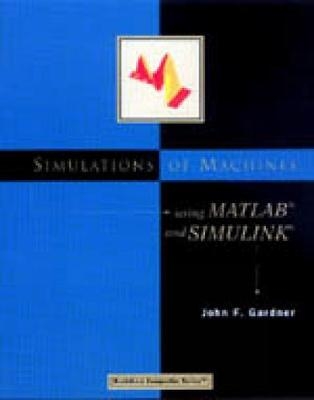
Simulations of Machines Using MATLAB® and SIMULINK®
CL Engineering (Verlag)
978-0-534-95279-2 (ISBN)
- Titel ist leider vergriffen;
keine Neuauflage - Artikel merken
This book is intended as a supplement for undergraduate courses in Kinematics or Dynamics of Mechanisms, taught in Mechanical Engineering departments. As a MATLAB® supplement, it can be used with any standard textbook, including Norton's DESIGN OF MACHINERY Second Edition, Erdman/Sandor's MECHANISMS DESIGN, Third Edition, or Mabie/Reinholtz MECHANISMS AND DYNAMICS OF MACHINERY, Fourth Edition. The emphasis of the text is integrating the computational power of MATLAB® into the analysis and design of mechanisms. This new book in Brooks/Cole's Bookware Companion Series™ is the first to apply the use of MATLAB® to the study of kinematics and dynamics of mechanisms. This book is intended as a useful guide for readers interested in understanding kinematics, or as a reference for practicing mechanical engineers. It provides detailed instruction and examples showing how to use MATLAB® (increasingly, the software program of choice among engineers for complex computations) and its accompanying simulation environment, SIMULINK®, to develop powerful and accurate computer simulations of constrained mechanical systems.
Dr. John Gardner is Director, CAES Energy Efficiency Research Institute at Boise State University. As a member of the City of Boise Climate Protection Committee and the Boise Public Works Commission, Dr. Gardner has worked on citywide programs to minimize energy consumption through better planning, incentives for efficient design and changes in city operations. He also is a member of the Idaho Power Integrated Resource Plan Advisory Committee, which helps the utility make decisions regarding the evolving needs of customers. In his current work through Boise State’s Division of Research, Dr. Gardner deals directly with facilities managers, electric utility representatives, state officials and executives to plan for sustainability programs. As EERI moves forward, he will continue guiding energy research, environmental policy and campus sustainability efforts at Boise State. These efforts have exposed many potential research issues that could be explored and applied more broadly through EERI.
1. INTRODUCTION
Why Simulate Mechanisms? / Kinematic Simulations / Dynamic Simulation of Mechanisms / Cross Reference with Traditional Kinematics Texts / Summary
2. VECTOR LOOP AND VECTOR CHAIN EQUATIONS
Introduction / The Planar Vector / Single Loop Equations / Derivatives of Vectors / Other Common Mechanisms / Vector Chains / Summary
3. SOLUTIONS OF THE POSITION PROBLEM
Overview / Numerical Solutions of Nonlinear Algebraic Equations / The Position Problem of a Four-Bar Linkage / MATLAB Solution of the Position Problem of a Four-Bar Linkage / Position Solutions and Initial Guesses / Summary
4. KINEMATIC SIMULATIONS USING SIMULINK®
What Is a Kinematic Simulation? / Velocity Solution via Kinematic Simulation / Acceleration Solution via Kinematic Simulation / The Consistency Check / Kinematic Simulation of a Four-Bar Mechanism / Summary
5. INTRODUCING DYNAMICS
Introduction / Step 1: Simulation of Slider on Inclined Plane / Step 2: Adding the Pendulum / Step 3: Assembling the Matrix Equation / Step 4: Create a Dynamic Simulation / Step 5: Set Initial Conditions and Run Simulation / Summary
6. THE SIMULTANEOUS CONSTRAINT METHOD
Introduction / Description of the Approach / Application of Simultaneous Constraint Method for the Slider Crank / Dynamic Simulation of the Slider Crank / Simulation Studies of the Slider Crank / Summary
7. SIMULATING MECHANISMS THAT CHANGE
The Geneva Mechanism / Summary
8. TWO-LINK PLANAR ROBOT
Overview / Vector Equations / Dynamic Equations / The Simultaneous Constraint Matrix / Dynamic Simulation / Robot Coordinate Control / Conclusions
9. THE TREBUCHET
Introduction / The Vector Loop / The Equations of Motion / The Matrix Equation / The Dynamic Simulation / Simulation Results / Summary
| Sprache | englisch |
|---|---|
| Maße | 187 x 235 mm |
| Gewicht | 261 g |
| Themenwelt | Informatik ► Grafik / Design ► Digitale Bildverarbeitung |
| Mathematik / Informatik ► Mathematik ► Computerprogramme / Computeralgebra | |
| Technik ► Maschinenbau | |
| ISBN-10 | 0-534-95279-8 / 0534952798 |
| ISBN-13 | 978-0-534-95279-2 / 9780534952792 |
| Zustand | Neuware |
| Informationen gemäß Produktsicherheitsverordnung (GPSR) | |
| Haben Sie eine Frage zum Produkt? |
aus dem Bereich


